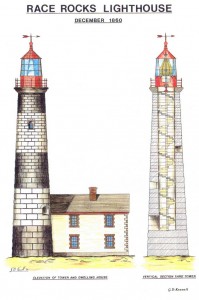 On Boxing Day 1860 the magnificent Imperial Light on the treacherous Race Rocks Islets was lit for the first time. Untill 1997, without interruption, a succession of dedicated lightkeepers tended the light as a vital aid to navigation for ships transiting the Strait of Juan de Fuca bound for the ports of Victoria, Vancouver, Seattle and the inside passage. The urgent need for a light on Race Rocks had become obvious to the British Admiralty in the early 1850’s. The new American light at Cape Flattery marked the southern shore of the entrance to the Strait of Juan de Fuca. The great tall ships of the mid 1800’s made the turn to starboard and found themselves in the darkened strait with the added complications of navigating an inland waterway with variable winds and extremely challenging tidal conditions. The name Race Rocks refers to the tidal race which swirls past the rocky outcrops at speeds of up to 8 knots. Located just over one nautical mile from Rocky Point, the southern most point on Vancouver Island, Race Rocks is the most southerly part of Canada on the Pacific Coast. The extraordinary tidal flow, one of the strongest on the coast, is not surprising when one considers that the entire flow of a one or two fathom tidal change for all of Georgia Strait, Haro Strait and Puget Sound rushes past Race Rocks twice each day. At the narrowest point in the Strait of Juan de Fuca, with only 12 nautical miles separating it from the American shore, Race Rocks is swept not only by the strong tides but also the surging waves of the Pacific. Victoria in the 1850’s was emerging as an important economic centre. The booming timber business and excellent harbours at both Victoria and Esquimalt resulted in a significant increase in shipping. Captain George Richards aboard the vessel Plumper was surveying the coast for the British Admiralty in London. In his letter to the Admiralty that accompanied Captain Richards’ report, Rear-Admiral Robert Baynes wrote: “a great want which is felt by all vessels coming to Vancouver’s Island of a light on the North shore on the Race Islands or Rocks.” Baynes wrote that it was “almost impossible after dark” to make Victoria Harbour “as the entrance [is] so difficult to distinguish.” On Boxing Day 1860 the magnificent Imperial Light on the treacherous Race Rocks Islets was lit for the first time. Untill 1997, without interruption, a succession of dedicated lightkeepers tended the light as a vital aid to navigation for ships transiting the Strait of Juan de Fuca bound for the ports of Victoria, Vancouver, Seattle and the inside passage. The urgent need for a light on Race Rocks had become obvious to the British Admiralty in the early 1850’s. The new American light at Cape Flattery marked the southern shore of the entrance to the Strait of Juan de Fuca. The great tall ships of the mid 1800’s made the turn to starboard and found themselves in the darkened strait with the added complications of navigating an inland waterway with variable winds and extremely challenging tidal conditions. The name Race Rocks refers to the tidal race which swirls past the rocky outcrops at speeds of up to 8 knots. Located just over one nautical mile from Rocky Point, the southern most point on Vancouver Island, Race Rocks is the most southerly part of Canada on the Pacific Coast. The extraordinary tidal flow, one of the strongest on the coast, is not surprising when one considers that the entire flow of a one or two fathom tidal change for all of Georgia Strait, Haro Strait and Puget Sound rushes past Race Rocks twice each day. At the narrowest point in the Strait of Juan de Fuca, with only 12 nautical miles separating it from the American shore, Race Rocks is swept not only by the strong tides but also the surging waves of the Pacific. Victoria in the 1850’s was emerging as an important economic centre. The booming timber business and excellent harbours at both Victoria and Esquimalt resulted in a significant increase in shipping. Captain George Richards aboard the vessel Plumper was surveying the coast for the British Admiralty in London. In his letter to the Admiralty that accompanied Captain Richards’ report, Rear-Admiral Robert Baynes wrote: “a great want which is felt by all vessels coming to Vancouver’s Island of a light on the North shore on the Race Islands or Rocks.” Baynes wrote that it was “almost impossible after dark” to make Victoria Harbour “as the entrance [is] so difficult to distinguish.”
- From the British Colonist of August 12, 1859 ” the HMS Plumper left Esquimalt to select a site for a light house on Race Rocks. The site selected was on the outer island of Great Race Rocks, on the southern side about 25 feet above the water. —–When coming up the Straits of Juan de Fuca, by keeping a mile off Race Rocks, and steering about north, that course will lead to Fishguard (sic) Island, leaving Albert Head half a mile distant. After selecting the site the commissioners proceeded to Fishguard island, at the mouth of the Esquimalt harbor and there fixed the site for the Harbor light-house. The distance from Race Rocks to Fishguard island is nine miles. The erection of the lighthouses will be commenced immediately. And it is possible the lanterns will arrive from England before the towers— which are to be built of stone— can be completed “
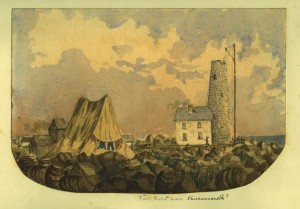 Construction of the Race Rocks Lighthouse in 1860 It ended up that Race Rocks was the only tower ever constructed of stone on the Pacific Coast. The much smaller second lighthouse at Fisgard Island was constructed from brick.
This BC Archives painting from the summer of 1860 depicts the construction of the tower . This link provides further information derived from the details of the picture.
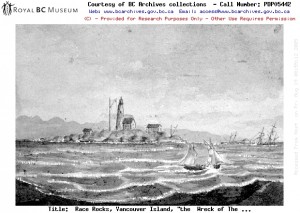 The shipwreck the Nanette in 1860 a few days before the lightstation became operable.
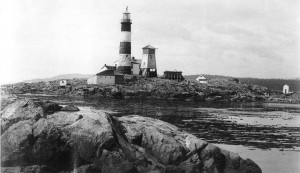 A 1915 image from the BC Archives. Located just over one nautical mile from Rocky Point, the southern most point on Vancouver Island, Race Rocks is the most southerly part of Canada on the Pacific Coast. The extraordinary tidal flow, one of the strongest on the coast, is not surprising when one considers that the entire flow of a one or two fathom tidal change for all of Georgia Strait, Haro Strait and Puget Sound rushes past Race Rocks twice each day. At the narrowest point in the Strait of Juan de Fuca, with only 12 nautical miles separating it from the American shore, Race Rocks is swept not only by the strong tides but also the surging waves of the Pacific.
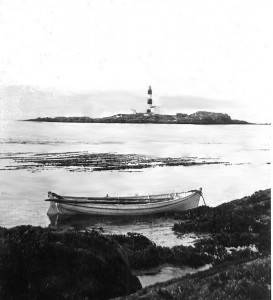 An early 1900s image from the BC Archives. Added to the urgent need for a navigation aid, was the political reason that the colonial government had to assert its territorial boundary, as there had been an influx of thousands of Americans up into the Frazer river in the Gold rush. |
The construction of the Race Rocks light house was a remarkable undertaking. The Admiralty selected Scottish granite that was cut and numbered in Scotland and then shipped as ballast in an outbound timber ship for assembly at Race Rocks. Throughout the summer of 1860 the massive stones were barged from the harbour to the Race and assembled using timber derricks and scaffolding. The workers struggled with the construction project through the spring summer and fall of 1860.
ADDITIONAL HISTORICAL NOTE:From The Times of Britain, May 9 January 1860: “THE ROYAL NAVY OF 1860.- By the official Navy List for the present month and quarter we find that the British navy consists o£ 518 vessels, including screw steamers of every description, exclusive of which there are 153 gunboats, 121 brigs, hulks, &c., employed in harbour service, and 47 coastguard tenders. Of the number of vessels composing the navy no less than 314 are in commission and doing duty in every part of the globe. The vessels in commission are distributed as follows:- 65 line-of-battle ships, frigates, sloops, and gunboats attached to the East Indies and China station, 18 on the Coast of Africa, 6 at Australia, 13 in the Pacific, 3 in the Brazils, 8 on the south-east coast of America, 8 at the Cape of Good Hope, 21 on the North America and West India station, 41 in the Mediterranean, 19 attached to the Channel squadron, and the remaining 112 are employed on particular service or attached as guardships to the principal ports in Great Britain and Ireland. The HMS Topaze (1858) was one of the “Channel Squadron” Some of the crew of the Topaze, a 24-gun Liffey class wooden screw frigate of the Royal Navy with 560 men assisted in the building of the Lighthouse. John Welbore Sunderland Spencer R.N.(1816-1888) , the sixth son of Francis Almeric Spencer (1st Baron Churchil, 1779-1845) and grandson of George, 3rd Duke of Marlborough was Captain of the Topaze from 11 June 1859 to 31 December 1863 (from commissioning at Plymouth until paying off at Plymouth), Channel squadron, then (October 1859) Pacific (Commodore, senior officer on the southern division of the Pacific station)”This same ship in 1868 was responsible for removing the Moai from Easter Island and shipping them to England as a gift for Queen Victoria. They were then given to the British Museum.An additional reference from the Rapanui website states the following: Race Rock Lighthouse in British Colombia, Canada, was built by the crew of HMS Topaz and outside laborers under a contract awarded to John Morris.
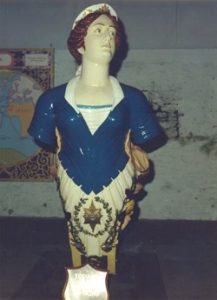 http://figureheads.ukmcs.org.uk/hms-topaze/ http://figureheads.ukmcs.org.uk/hms-topaze/
This website shows this figurehead of the Topaze
(SEE THIS UPDATE FILE which presents a different version of Construction) This file of the Royal Engineers presents the “quarried in Scotland “version alsoIn this file I have accumulated several archival entries from the Daily Colonist which refer to the early (1860’s-1900’s) Race Rocks History.
Shipwrecks at Race Rocks:
A summary index of the shipwrecks at or around Race Rocks is available here.Three days prior to the official operating date for the lighthouse (December 25, 1860) the Nanette, a British vessel carrying sawmill machinery and Hudson’s Bay Company merchandise, ran into thick fog by early evening and was swept up by the swift tide along the shoals. Early the next morning the Nanette was thrown against the rock by a seven-knot tide and the vessel began to sink. The salvage operation became difficult when news of the cargo’s value (estimated $200,000) spread, attracting many looters, and requiring officers and sailors to police the area. Further salvage of the vessel came to a stop in 1861 when the Nanette was swept to the depth of 15 fathoms in foul weather.
(http://mmbc.bc.ca/source/lighthouse/racerock.aspl)Soon after the light went into service in 1860 it became obvious that the tower was difficult to see by day when approaching from the west. Distinctive black and white stripes were painted on the tower by the first lightkeeper George Davies to improve it’s visibility against the shoreline. These markings remain today maintaining Race Rock’s unique appearance. Although the light was a great improvement on clear nights when it was visible for 18 miles the hazards of Race Rocks were still very real in fog.The islets are shrouded in fog for up to 45 days a year. With only the station bell for a keeper to sound in the fog, the Race continued to be the final resting place of the ships of unsuspecting crews drawn to the reefs by the relentless tide rips.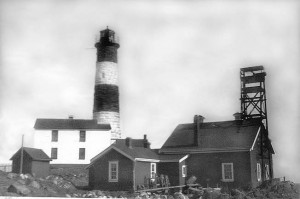 In 1892 the Department of Marine and Fisheries installed a steam plant and two compressed air fog horns at Race Rocks. The Department had taken over operation of lighthouses from the British Admiralty in 1871 when British Columbia joined the Dominion of Canada. Despite the addition of the powerful horns tragedies continued at Race Rocks.The issue of the reliability of the lightkeepers and the operation of the horns at Race Rocks was finally resolved in May 1929 when the Hydrographic Survey ship Lillooet conducted an investigation of the so called silent zone the keepers and various ships masters had always claimed existed. The Lillooet expedition proved that an unusual deflection of the sound as a result of the location of the horns was in fact a serious problem. The horns were then moved to a separate tower and for the first time were truly useful. (Compare the location of the foghorn byt he engine room in the picture above from the 1920s with the one above of the 1915 location . In 1892 the Department of Marine and Fisheries installed a steam plant and two compressed air fog horns at Race Rocks. The Department had taken over operation of lighthouses from the British Admiralty in 1871 when British Columbia joined the Dominion of Canada. Despite the addition of the powerful horns tragedies continued at Race Rocks.The issue of the reliability of the lightkeepers and the operation of the horns at Race Rocks was finally resolved in May 1929 when the Hydrographic Survey ship Lillooet conducted an investigation of the so called silent zone the keepers and various ships masters had always claimed existed. The Lillooet expedition proved that an unusual deflection of the sound as a result of the location of the horns was in fact a serious problem. The horns were then moved to a separate tower and for the first time were truly useful. (Compare the location of the foghorn byt he engine room in the picture above from the 1920s with the one above of the 1915 location .
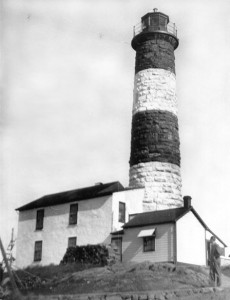 Lightkeepers of the coast were the heroes of the new frontier and the burgeoning coastal communities. Their living conditions were extremely difficult. The original stone house at the base of the light tower at Race Rock was very drafty and damp. In southeast gales the rain penetrated the cement joints in the structure. At some stations the keepers claimed the curtains flapped in a good gale! The first keeper’s time at the Race was a very unfortunate one. George Davies and his wife Rosina eagerly awaited the visit of her brother, sister-in-law and three friends on Christmas Day 1865. As the skiff approached with the Davies family watching and waving from the station, a tide rip only 20 feet from the jetty swept the small boat away, capsizing it and dumping the shocked passengers and their Christmas gifts into the water. The station had no boat at this time and each the unfortunate visitors perished. The new year was no better for the Davies family. During the winter of 1866 George became seriously ill. The Union Jack flew at half mast at the station as a signal of distress for nine days but to no avail. George Davies died at the Race shortly before Christmas 1866.In 1867 Thomas Argyle was appointed as Chief Keeper of Race Rocks Light at an annual salary of $630. His wife Ellen was retained as matron at $150 and two assistant keepers were hired at a salary of $390 each for the year. Supplying the station was always difficult as it involved rowing out from Victoria but at least the Admiralty paid up to $900 a year for supplies. The employment conditions for the keeper of Race Rocks were relatively good at this time compared to the situation after 1871 when the new Dominion Government took over the lights. Argyle’s annual salary was then cut to a paltry $125 and he was expected to pay for his own assistants and all supplies. Argyle apparently took to the sea to supplement his food supplies. His family had grown considerably as six children were born to the Argyles at Race Rocks. He was known to dive into the frigid waters around the station in search of abalone, scallops and mussels.It seems that Thomas Argyle’s luck suddenly changed in about 1885. The Colonist newspaper reported that he was paying for his weekly supplies in Victoria with gold sovereigns. When Thomas died thirty years later at the age of eighty he had still not exhausted his apparently endless supply of gold coins. It would appear that Thomas Argyle’s diving expeditions had resulted in the discovery of sunken treasure. “The sea provides!” Argyle served at Race Rocks for twenty-one years and retired in 1888. One son was drowned at age 19 when returning from Victoria with a friend. Another son Albert took over as temporary keeper until a new appointment was made on January 1, 1889. According to descendants of Argyle they would not allow him to stay on as keeper because he was not married!A watery grave: Thomas Argyle Jr., at 25 years of ageLightkeeper Argyle searches and is unable to find his son and other drowning victims.Appointments to government jobs were always closely linked with political patronage. The appointment of W.P. Daykin who came from Sand Head station was clearly influenced in this way. Daykin served for three years before moving on to Carmanah Light Station on the outside coast. ( See the British Colonist references) Frederick Eastwood, his wife and three children moved to Race Rocks in April 1891. When Eastwood hired two Japanese assistants the discriminatory attitudes of the times befell him. He was charged with dereliction of duty when the local MP Colonel Edward G. Prior wrote to the Minister in the fall of 1900 stating that “for a long time past this lighthouse has been in the charge of two Japanese instead of a white man” The Minister Louis Davies replied that “The Department was not desirous to encourage in any way the employment of these men.” White men should have the preference. Eastwood served until he retired in 1919.A second keeper was lost in a tragedy on January 23 1950. Arthur Anderson left his wife and two children to obtain supplies ashore and never returned. His skiff turned up empty along the American shore near Port Angeles. Anderson was never found.In the early 1960’s , the old stone house attached to the bottom of the tower was destroyed under the “efficiency policies” of the time by the Canadian Coast Guard Lightkeepers of the coast were the heroes of the new frontier and the burgeoning coastal communities. Their living conditions were extremely difficult. The original stone house at the base of the light tower at Race Rock was very drafty and damp. In southeast gales the rain penetrated the cement joints in the structure. At some stations the keepers claimed the curtains flapped in a good gale! The first keeper’s time at the Race was a very unfortunate one. George Davies and his wife Rosina eagerly awaited the visit of her brother, sister-in-law and three friends on Christmas Day 1865. As the skiff approached with the Davies family watching and waving from the station, a tide rip only 20 feet from the jetty swept the small boat away, capsizing it and dumping the shocked passengers and their Christmas gifts into the water. The station had no boat at this time and each the unfortunate visitors perished. The new year was no better for the Davies family. During the winter of 1866 George became seriously ill. The Union Jack flew at half mast at the station as a signal of distress for nine days but to no avail. George Davies died at the Race shortly before Christmas 1866.In 1867 Thomas Argyle was appointed as Chief Keeper of Race Rocks Light at an annual salary of $630. His wife Ellen was retained as matron at $150 and two assistant keepers were hired at a salary of $390 each for the year. Supplying the station was always difficult as it involved rowing out from Victoria but at least the Admiralty paid up to $900 a year for supplies. The employment conditions for the keeper of Race Rocks were relatively good at this time compared to the situation after 1871 when the new Dominion Government took over the lights. Argyle’s annual salary was then cut to a paltry $125 and he was expected to pay for his own assistants and all supplies. Argyle apparently took to the sea to supplement his food supplies. His family had grown considerably as six children were born to the Argyles at Race Rocks. He was known to dive into the frigid waters around the station in search of abalone, scallops and mussels.It seems that Thomas Argyle’s luck suddenly changed in about 1885. The Colonist newspaper reported that he was paying for his weekly supplies in Victoria with gold sovereigns. When Thomas died thirty years later at the age of eighty he had still not exhausted his apparently endless supply of gold coins. It would appear that Thomas Argyle’s diving expeditions had resulted in the discovery of sunken treasure. “The sea provides!” Argyle served at Race Rocks for twenty-one years and retired in 1888. One son was drowned at age 19 when returning from Victoria with a friend. Another son Albert took over as temporary keeper until a new appointment was made on January 1, 1889. According to descendants of Argyle they would not allow him to stay on as keeper because he was not married!A watery grave: Thomas Argyle Jr., at 25 years of ageLightkeeper Argyle searches and is unable to find his son and other drowning victims.Appointments to government jobs were always closely linked with political patronage. The appointment of W.P. Daykin who came from Sand Head station was clearly influenced in this way. Daykin served for three years before moving on to Carmanah Light Station on the outside coast. ( See the British Colonist references) Frederick Eastwood, his wife and three children moved to Race Rocks in April 1891. When Eastwood hired two Japanese assistants the discriminatory attitudes of the times befell him. He was charged with dereliction of duty when the local MP Colonel Edward G. Prior wrote to the Minister in the fall of 1900 stating that “for a long time past this lighthouse has been in the charge of two Japanese instead of a white man” The Minister Louis Davies replied that “The Department was not desirous to encourage in any way the employment of these men.” White men should have the preference. Eastwood served until he retired in 1919.A second keeper was lost in a tragedy on January 23 1950. Arthur Anderson left his wife and two children to obtain supplies ashore and never returned. His skiff turned up empty along the American shore near Port Angeles. Anderson was never found.In the early 1960’s , the old stone house attached to the bottom of the tower was destroyed under the “efficiency policies” of the time by the Canadian Coast Guard
|
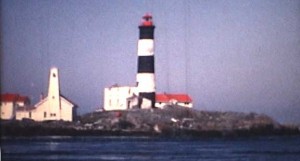 Go to this file for a video of some of the demolition of historic structures which were on the island Go to this file for a video of some of the demolition of historic structures which were on the island |
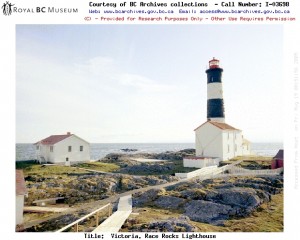 This image from the BC Archives (I-03698) shows the old stone house attached to the base of the tower.
This image from the BC Archives (I-03698) shows the old stone house attached to the base of the tower.
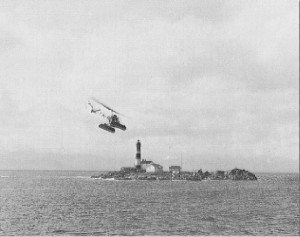
In this pre-1970 image the blacksmith shop appears as a long low building at the base of the tower
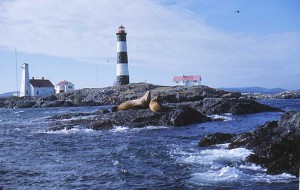
In the early 1960’s , the old stone house attached to the bottom of the tower was destroyed under the “efficiency policies” of the time by the Canadian Coast Guard
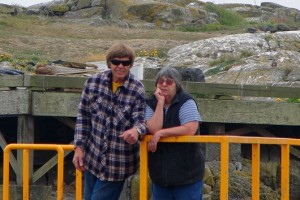
This picture by Gil Parker appeared in a in a story in the Times Colonist , March 5, 2000, about Race Rocks and Pearson College. It is valuable as it shows the wooden foghorn tower beside the engine room before it was demolished in 1972
In 1979, Trev Anderson compiled a list of the Senior Lighthouse keepers to assist some students from Pearson College who were doing a marine history project in marine science. See this table with our updated list of Lightkeepers and Assistant Lightkeepers at Race Rocks from 1860 to 1997.
We often hear from individuals who have had relatives as keepers or assistants on the island in the past. We have been able to add these names to our list above (see blue links) and we would appreciate any other information you may be able to provide in order to add to this historical record. Please contact Garry Fletcher.
The BC Archives is the central archives service for the government of British Columbia. Many of the early historic photos of Race Rocks come from this archive. These and other valuable historic documentation may be found at http://www.bcarchives.gov.bc.ca/
Be sure to see this version of the construction of the lighthouse provided with new information from archival material at Fisgard Island.
Go to the HISTORY INDEX for Race Rocks
See the early History of Race Rocks Lighthouse part 2
 On Boxing Day 1860 the magnificent Imperial Light on the treacherous Race Rocks Islets was lit for the first time. Untill 1997, without interruption, a succession of dedicated lightkeepers tended the light as a vital aid to navigation for ships transiting the Strait of Juan de Fuca bound for the ports of Victoria, Vancouver, Seattle and the inside passage. The urgent need for a light on Race Rocks had become obvious to the British Admiralty in the early 1850’s. The new American light at Cape Flattery marked the southern shore of the entrance to the Strait of Juan de Fuca. The great tall ships of the mid 1800’s made the turn to starboard and found themselves in the darkened strait with the added complications of navigating an inland waterway with variable winds and extremely challenging tidal conditions. The name Race Rocks refers to the tidal race which swirls past the rocky outcrops at speeds of up to 8 knots. Located just over one nautical mile from Rocky Point, the southern most point on Vancouver Island, Race Rocks is the most southerly part of Canada on the Pacific Coast. The extraordinary tidal flow, one of the strongest on the coast, is not surprising when one considers that the entire flow of a one or two fathom tidal change for all of Georgia Strait, Haro Strait and Puget Sound rushes past Race Rocks twice each day. At the narrowest point in the Strait of Juan de Fuca, with only 12 nautical miles separating it from the American shore, Race Rocks is swept not only by the strong tides but also the surging waves of the Pacific. Victoria in the 1850’s was emerging as an important economic centre. The booming timber business and excellent harbours at both Victoria and Esquimalt resulted in a significant increase in shipping. Captain George Richards aboard the vessel Plumper was surveying the coast for the British Admiralty in London. In his letter to the Admiralty that accompanied Captain Richards’ report, Rear-Admiral Robert Baynes wrote: “a great want which is felt by all vessels coming to Vancouver’s Island of a light on the North shore on the Race Islands or Rocks.” Baynes wrote that it was “almost impossible after dark” to make Victoria Harbour “as the entrance [is] so difficult to distinguish.”
On Boxing Day 1860 the magnificent Imperial Light on the treacherous Race Rocks Islets was lit for the first time. Untill 1997, without interruption, a succession of dedicated lightkeepers tended the light as a vital aid to navigation for ships transiting the Strait of Juan de Fuca bound for the ports of Victoria, Vancouver, Seattle and the inside passage. The urgent need for a light on Race Rocks had become obvious to the British Admiralty in the early 1850’s. The new American light at Cape Flattery marked the southern shore of the entrance to the Strait of Juan de Fuca. The great tall ships of the mid 1800’s made the turn to starboard and found themselves in the darkened strait with the added complications of navigating an inland waterway with variable winds and extremely challenging tidal conditions. The name Race Rocks refers to the tidal race which swirls past the rocky outcrops at speeds of up to 8 knots. Located just over one nautical mile from Rocky Point, the southern most point on Vancouver Island, Race Rocks is the most southerly part of Canada on the Pacific Coast. The extraordinary tidal flow, one of the strongest on the coast, is not surprising when one considers that the entire flow of a one or two fathom tidal change for all of Georgia Strait, Haro Strait and Puget Sound rushes past Race Rocks twice each day. At the narrowest point in the Strait of Juan de Fuca, with only 12 nautical miles separating it from the American shore, Race Rocks is swept not only by the strong tides but also the surging waves of the Pacific. Victoria in the 1850’s was emerging as an important economic centre. The booming timber business and excellent harbours at both Victoria and Esquimalt resulted in a significant increase in shipping. Captain George Richards aboard the vessel Plumper was surveying the coast for the British Admiralty in London. In his letter to the Admiralty that accompanied Captain Richards’ report, Rear-Admiral Robert Baynes wrote: “a great want which is felt by all vessels coming to Vancouver’s Island of a light on the North shore on the Race Islands or Rocks.” Baynes wrote that it was “almost impossible after dark” to make Victoria Harbour “as the entrance [is] so difficult to distinguish.”
 Go to this file for a video of some of the demolition of historic structures which were on the island
Go to this file for a video of some of the demolition of historic structures which were on the island This image from the BC Archives (I-03698) shows the old stone house attached to the base of the tower.
This image from the BC Archives (I-03698) shows the old stone house attached to the base of the tower.









